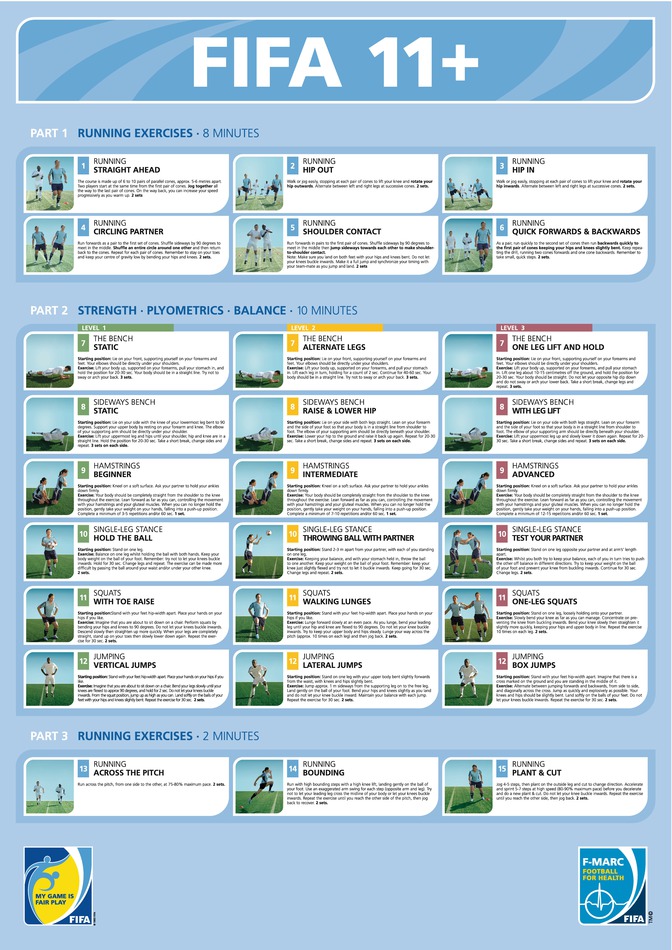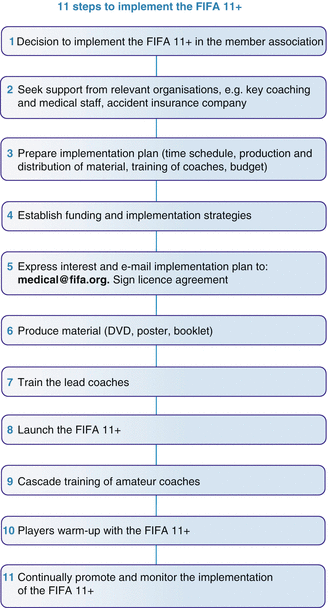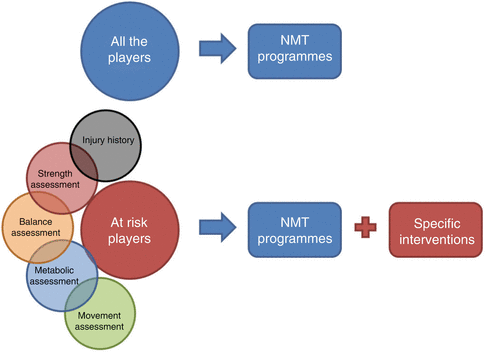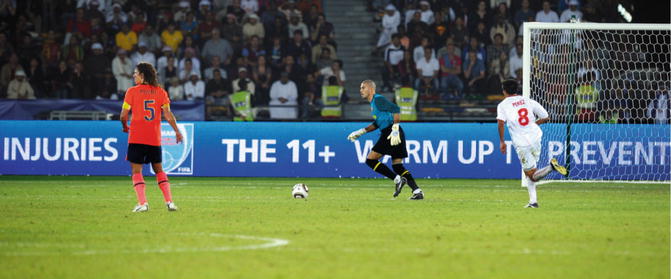Fig. 11.1
The figure of the ambassador should be a coach or a famous player to implement the message worldwide
11.2 Implementation of Prevention Programmes
Physical activity is associated with specific health benefits, including prevention of chronic diseases [38]. Injuries are indeed a common consequence of physical activity, and their management in sports, such as football (soccer), is difficult in terms of costs and time loss for the athlete, for the team and for the society as well [22]. It is known and well accepted that severe injuries take time to recover or can lead to an early retirement and to long-term consequences. For example, a majority of athletes sustaining an ACL injury will develop early osteoarthritis [23]. A variety of injury prevention exercise programmes (IPEPs) have been shown to be effective in reducing the injury rate [5, 16, 19, 20, 24, 29, 37]. Typically, these programmes consist of exercises focusing on balance, core stability, muscle strength and stretching. Examples of recent neuromuscular training (NMT) include a 5-phase 15 min programme [25], a 15-minute neuromuscular warm-up programme [37], the Prevent Injury and Enhance Performance programme (PEP) [24], The 11 [34] and The 11+ [29]. Although the effectiveness of these programmes has been demonstrated, compliance may be a critical factor in decreasing injuries [8]. To really prevent injuries and to have a significant public health impact, IPEPs need to be accepted, adopted and complied with by athletes, coaches, sports bodies and clubs [8]. Many studies demonstrated that players with high adherence/compliance had significantly lower injury risk [13, 30, 32]. In a recent meta-analysis, for example, Sugimoto et al. found that the incidence of ACL injury was lower in studies with good adherence to NMT [35].
Implementation of injury prevention programmes represents a real challenge in sports medicine [9]. The key point for future sports injury prevention is to reduce the “research to practice” gap [15]. It is mandatory to translate evidence into practice to establish the real effectiveness of these programmes.
As an example, we will discuss what the Fédération Internationale de Football Association (FIFA) has done in the past years and what it keeps on doing.
11.2.1 Implementation of the FIFA 11+ Football Warm-Up
The FIFA Medical Assessment and Research Centre (F-MARC), founded in 1994, has worked extensively in the development, scientific evaluation and dissemination strategies of FIFA’s injury prevention programmes (i.e. FIFA 11+) [1]. The FIFA 11+ is a simple, and easy-to-implement, sports injury prevention programme (Fig. 11.2). It is a 20 min complete warm-up programme consisting of 15 single exercises, divided into three parts including initial and final running exercises with a focus on cutting, jumping and landing techniques (parts 1 and 3) and strength, plyometric, agility and field balance components (part 2). For each of the six conditioning exercises in part 2, The 11+ offers three levels of variation and progression [29]. Authors demonstrated a rate injury reduction of 37 % during matches and 29 % during training sessions [29]. The programme should be performed at the start of each training session, for at least twice a week. A key point in the programme is to use the proper technique during all of the exercises.


Fig. 11.2
The “FIFA 11+” programme is a classic example of NMT programme
Basically, all researches were conducted in amateur/recreational football, which accounts for about 99 % of the 300 million players worldwide [7]. The F-MARC team has gained experience during the years of dissemination of the injury prevention programmes, especially through the countrywide campaigns in Switzerland, New Zealand and recently Germany.
11.2.2 Development of a Dissemination Strategy
The coach is the key person to promote injury prevention to his/her players [33]. While the coach, especially at a low level (where no staff personnel is available), has to oversee various aspects in the training (e.g. fitness, tactics), it is important to raise his/her motivation to implement an injury prevention programme (just as one of the many components) with his/her team.
Information material on “FIFA 11+” was developed, produced and made available for coaches and players. The material includes a detailed manual, an instructional DVD, a poster, a website and a promotional booklet with DVD. The material is available in the four FIFA languages (English, Spanish, German and French) and can be accessed in www.F-MARC.com/11plus.
“FIFA 11+” is best taught to coaches in a workshop that includes theoretical background knowledge and moreover practical demonstration of the exercises.
For the countrywide campaign in Switzerland, “The 11” was integrated in the coaching education of the Swiss Football Association (Schweizerischer Fussballverband (SFV)) using a “teach the teacher” strategy. All instructor coaches of the SFV were educated by sports physical therapists on how to deliver the programme in their licensing or refresher courses. During a period of 4 years, 5000 licensed amateur coaches were subsequently instructed on how to perform “The 11” with their teams and received the information material. In 2008, 80 % of all SFV coaches knew the prevention campaign “The 11” and 57 % performed the programme. Teams performing “The 11” had an 11.5 % lower incidence of match injuries and 25.3 % lower incidence of training injuries than other teams [18].
The same strategy was used in New Zealand, where “The 11” was implemented as part of the “SoccerSmart programme”.
11.2.3 Worldwide Dissemination of “FIFA11+”
In 2009, FIFA started the dissemination of the “FIFA 11+” in its 209 member associations (MAs). Based on the experience with the countrywide campaigns, a guideline on how to implement the “FIFA 11+” injury prevention programme at a larger scale in amateur football was developed (Fig. 11.3). “FIFA 11+” has also been presented to the delegates of all MAs at the last two FIFA medical conferences (Zürich 2009, Budapest 2012). The implementation is conducted either in close cooperation with MAs or via FIFA coaching instructor courses. F-MARC supports the MAs in the preparation of the educational material in the local language and the workshops for the first group of instructors to initiate the cascade training. At MA level, it has to be acknowledged that highly motivated people are needed, in order to successfully plan, realise and constantly monitor a countrywide implementation.


Fig. 11.3
Eleven steps to implement prevention programmes worldwide (example from “FIFA 11+”)
The national Football Associations of Spain, Japan, Italy, Brazil and Germany integrated “FIFA 11+” in their coaching curriculum and/or in their physical training/education curriculum. Thus, the world football champions took the lead and acted as role models, and other MAs (about 15 in November 2014) followed.
In the span of 5 years (2009–2014), FIFA 11+ has been presented in more than 80 countries worldwide (all continents), and thousands of coaches have been instructed on how to implement the programme, thus representing an important step for the worldwide dissemination of FIFA 11+ and the concept of injury prevention in football.
11.2.4 Socioeconomic Impact of Injury Prevention at Large Scale
The two countrywide campaigns in Switzerland and New Zealand represent successful examples of injury prevention in amateur football. Gianotti et al. introduced pre- and post-implementation cost outcome formulae to provide information regarding the success of a prevention programme [12]. These data provide a return on investment for each dollar invested in the programme and cost savings. Since the SoccerSmart programme (including the “The 11” programme) was introduced in New Zealand in 2004, the Accident Compensation Corporation (ACC) has invested 650,000 NZ dollars. Up to June 2011, ACC has saved 5,331,000 NZ dollars: the return of investment has risen to 8.20 for each invested dollar (personal communication of Dr. S. Gianotti, ACC, New Zealand). These data, together with the published results of the countrywide implementation in Switzerland, reinforce the hypothesis outlined by F-MARC back in 1994: prevention measures or programmes can not only reduce the incidence of football injuries but have the potential to save billions of dollars in health-related costs worldwide.
11.3 Target Groups for Prevention
Prevention programmes are thought to be applied in the same way to very different athlete groups. This approach is the one presented in the most part of articles. Whether or not a preseason evaluation based on movement analysis and athlete’s clinical history will be useful has to be determined in further studies. Hewett et al. evaluated a large number of young female athletes in the preseason and built a predictive model for ACL injury risk based on a drop-jump analysis [17]. So the most logic approach may be to split in two the prevention concept: general prevention (through the well-known neuromuscular programmes) and tailored prevention (based on the player’s risk profile) (Fig. 11.4).


Fig. 11.4
General and tailored prevention based on the player’s characteristics and preseason evaluation
In terms of general prevention, we strongly advice to implement prevention programmes on the two main categories of athletes: the recreational athletes and the young athletes.
If we really want to implement prevention and have a strong impact on public health, we need to target the recreational athletes (99 % of the 300 million football players worldwide). For recreational athletes we mean the competitive players of lower divisions (all sports) and the non-competitive recreational, maybe playing once a week without training. This is a hard challenge to be pursued. Regarding the first group, it is easiest to introduce prevention exercise as they play in a structured team with a dedicated staff or at least a coach, which has to be targeted for education. For the second group, public education programmes should be taught and implemented together with physical activity prescription. Moreover, in case of injury, a specific reinjury prevention programme should be learned.
Most researchers and doctors recommend starting prevention strategies as soon as possible. Generally, injury risk is low under the age of 12 [11]. The incidence of injury increases with age, and studies have shown that the injury rate among players aged 16 years or older approaches that of adult players [3, 6]. The focus on young athletes ideally brings two main advantages. First of all, having a good prevention strategy at a young age means improving the young athlete’s health also from a musculoskeletal perspective. Moreover, a proper education of the youngest means having a higher compliance of the future adult athletes. To reach the youngest, it is very important to involve the family and educate, first of all, their parents. Regarding the responsibility for implementing measures to reduce the risk of injury in the young population, Emery et al. argued that there is a hierarchy of responsibility with the lowest level of responsibility assigned to the child and the highest to those organisations (sports groups and government) that could potentially make the most change [4]. For example, an Australian legislation increased the helmet-wearing from 31 to 75 % in a year. This means that government regulation can make more changes compared to parent and child behaviour.
11.4 Ways of Publication of Prevention Programmes
First of all, the aim of an injury prevention research group is to check the effectiveness of the proposed NMT throughout prospective studies and subsequently share the findings with the scientific community. Among the 45 papers we reviewed during the writing of this chapter, we found that the most represented types of articles are prospective randomised controlled trial (RCT), prospective intervention study and statements. Prospective studies, possibly randomised, are the gold standard. An intervention and a control group need to be created. The control group may consist of a real group of different players without intervention or the same group of players in previous seasons.
Once the effectiveness of the NMT has been demonstrated, the scientific community has to deliver the programme to the public audience and to the sports community. This is what the international organisations, and in general all the sports bodies, are doing nowadays. Ways of “practical” publication have changed through the years, so, Web-based and app-based channels have to be carefully considered. Moreover, the organisation of workshops and courses for coaches and athletic trainers is still very important to spread out the message. The delivery of posters, DVD and pamphlets is fundamental as well. We need to use the right message to the right goal. For example, the right message to convince and motivate them is “injury prevention programme will reduce the risk by at least 50 %” instead of “injury prevention programme may reduce the risk” [26]. One of the keys while conducting a workshop or a course is “proposing” rather than “imposing” FIFA11+. After increasing the motivation of the coach and raising awareness of injury prevention, the exercises should be briefly explained and demonstrated. The participants should then perform the exercises and be corrected by the instructor(s), therefore appreciating the challenges (i.e. neuromuscular control!) behind each exercise. In the second half of the workshop, each of the participants should teach at least one of the exercises to the group and get feedback on this from the instructor. It is important to stress that regular and correct performance of the exercises is crucial for the preventive effect.
11.5 Importance of Media
Maybe the most important player on which we need to do prevention is the public audience. The sports medicine community needs the power of media and Web-based communication. Communication is evolving and the community is evolving too. Media can maximise the effort of a single man or organisation; the message may spread to the entire world and modify the way people think. This is what FIFA did during the World Cup in 2010 (Fig. 11.5), and they keep doing it through “The 11+” video sharing. Simple messages have to be transmitted to the audience.










